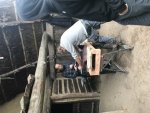Went to the archaeology museum in Hitzacker ( on the Elbe in Lower Saxony ) today. Some chaps doing practical hands on research by trying to grind axe heads. The one in the picture is as the man admitted to big to be useable but they like a challenge.
Had a good chat with them, one at least has a PhD in Archaeology and is very keen on the experimental side. He said its about 100 hours of work to make an axe head, a massive investment of time to us, but how did Palaeolithic people view time, and did they have slaves do some of it or was there an apprenticeship process ? So much we cannot know. And even if this method works we cannot be sure it was what was used then.

Sorry, no idea how to turn it round or insert the video clip I have of it.........
Had a good chat with them, one at least has a PhD in Archaeology and is very keen on the experimental side. He said its about 100 hours of work to make an axe head, a massive investment of time to us, but how did Palaeolithic people view time, and did they have slaves do some of it or was there an apprenticeship process ? So much we cannot know. And even if this method works we cannot be sure it was what was used then.

Sorry, no idea how to turn it round or insert the video clip I have of it.........
